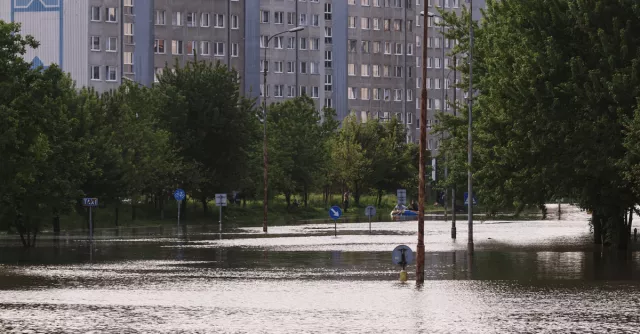Power Recovery: Myths, Facts, and Lessons Learned

Whether or not your business has been impacted by power loss in the past, preparing for fast power restoration is an absolute foundation in business sustainability. On average, losing power for just four hours costs an organization between $10,000 to $20,000, so the question is no longer whether companies can afford planning and recovery, but instead, how much will a business save by investing in a comprehensive business continuity plan that includes power restoration support?
Your company's safety, productivity, and revenue should never be left vulnerable to power loss. An effective power recovery plan includes strategies to address many contingencies. To do this, planners must avoid outdated power recovery myths and consider these critical facts:
Myth #1: Local vendors will be able to assist in the event of a major outage.
Fact: Without a formal agreement that includes guaranteed access to generators, fuel, and connection services, local vendors may allocate their inventory to larger organizations.
We recently supported a small business that believed their agreement with a local provider was all they needed to secure a backup power solution. Unfortunately, as storms took out critical lines throughout their community, the provider was approached by a larger corporation that needed all available generator inventory to support its various locations. Because the small business lacked buying power compared to their enterprise-sized competition, the vendor canceled their agreement with the small business to serve a larger customer with a bigger budget. Fortunately, Agility was able to step in and quickly source, service, and connect a generator for this small business. Otherwise, the vendor's questionable business practices could have meant a critical loss of revenue and reputation for the small business.
While it may seem safe to assume that what you need will be available when you need it, unpredictable storm seasons, supply chain issues, and inflated demand lead to severe resource scarcity and price gouging. When local availability is compromised, this could cost you days, weeks – or even longer – of downtime. If we've learned anything from disasters like Hurricanes Harvey and Ida, 9/11, and the initial panic of the COVID pandemic, local fuel scarcity can cause incredible delays and increases in the cost of recovery. Unless you manage a large fuel storage unit on site, your power recovery plan must include quick access to the kind of fuel you need to operate your business's gasoline- and diesel-dependent equipment.
Lesson: While Agility guarantees rapid deployment of power recovery assets to all contracted customers, many providers do not offer this promise. Be sure to get your power recovery agreement in writing and review contracts for clauses that allow vendors to prioritize larger customers. When securing power recovery assets, be sure to include a plan for quick delivery of fuel to keep your generators, vehicles, and other equipment operational.
Myth: Buying our own generator will provide our company with the best value and fastest power recovery.
Fact: The initial investment you make in a generator is just that – initial. Cost over time will only increase as the reliability of your unit inevitably decreases.
The investment made when a generator is purchased is only the beginning. Several factors significantly increase the total cost of a backup generator over time, including:
- Delivery and connection fees
- Ongoing maintenance
- Storage
- Training and testing
- Fuel
- Repairs
Even regularly serviced generators and other power recovery resources are vulnerable to damage caused by severe storms and other natural disasters. If your power restoration plan is entirely dependent on an on-site generator, you need to ensure that you have a reliable backup plan for your backup plan.
Lesson: Purchasing one or more backup generators may seem like an easy, cost-effective solution, but power equipment requires regular maintenance, servicing, and fuel, which could drive costs up year-over-year compared to securing power recovery services with fixed, pre-negotiated rates. And when an unexpected storm or disaster causes a major outage, there's no guarantee that on-site generators and fuel won't be impacted, too. An effective power restoration plan accounts for these contingencies and includes assured alternative access to generators, fuel, and licensed electrical support.
Myth: Storm-related outages haven't impacted our business before, so we don't need to invest in a power recovery plan.
Fact: Historically, storm-prone regions are no longer the only parts of North America where storms cause significant power outages. In addition to storm-related outages, non-weather-related power loss is also rising.
In recent years, some of the most damaging storms have been completely unseasonable and largely unpredictable. Lack of preparedness for these events – including the 2021 Texas ice storm – has resulted in critical community damage, economic loss, and permanent business closures. The United States' aging power grid means that storm-related power outages are more of a threat to all regions and that non-weather-related outages are a growing threat every business should be prepared for.
Common non-weather power outages are caused by various disruptions, including vehicles/accidents, animals, vandalism, trees, cyberattacks, and planned outages. Combined with a power grid in desperate need of an overhaul, these events are linked to more frequent, longer-lasting outages.
Lesson: Unseasonable and unpredictable storms will increase in regions not traditionally impacted by severe weather. As the threat of non-weather-related outages grows across North America, businesses everywhere are vulnerable to revenue and productivity impacts caused by power loss. An effective recovery plan with services that include access to generators, fuel, connection, and testing will return thousands over the program's cost after only one power-loss event.



